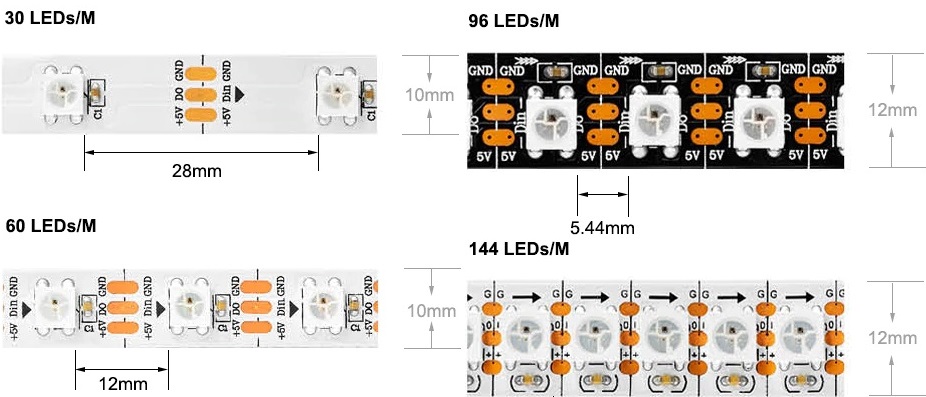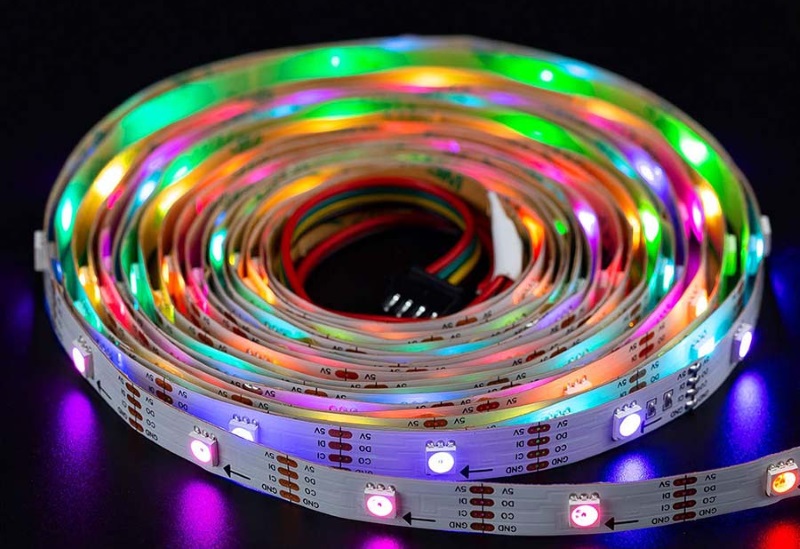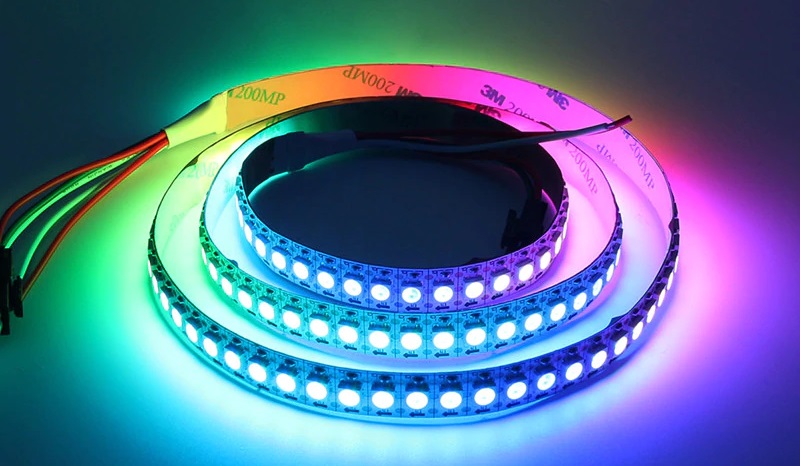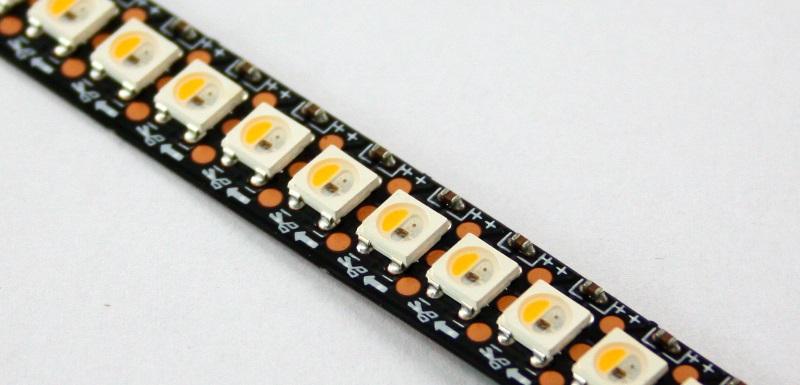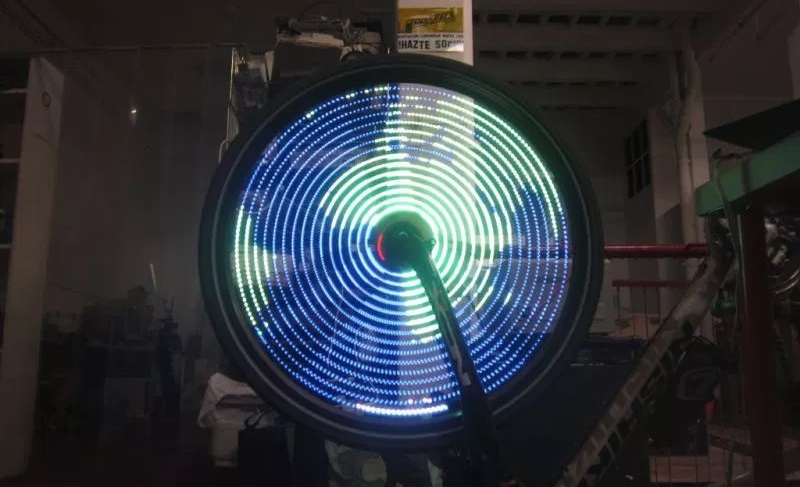What Digital 5v/12v/24v RGB(W) LED Strip to buy
Updated 2023-12!
In this article I’ll highlight what I think will be the most popular strips for people to buy and what situations I’d recommend those for. I’ve written a different article here explaining the difference and chips and what makes them unique so if you are interested make sure to read that also.
This article mainly focusses on standard 5050 package based addressable LED strip, if you are looking for other forms of addressable LEDs, please take a look at the following articles.
Most links will be to a supplier called BTF-Lighting (Amazon / Aliexpress). I’ve placed at least a dozen orders with them and have always received quality products so I can recommend them. I have also used a few different sellers on Aliexpress for some products so not all links go towards them, but still. Most LED chips and even LED strips only get made in a handful of factories so quality is most often going to be fine.
I am going to put up some generic use cases for most strips listed but make sure to also check out my article about 30 vs 60 vs 90 vs 144 LEDs/m strip and IP20 vs IP65 vs IP67 (waterproofing) to make sure you get the correct strip for your intended use case.
Especially with 5v LED strip you will probably need to add a few power injection points if you go beyond a 150 LEDs on a single strip. To learn more about power injection, wire sizes and how to calculate all of these things for your project, check out my 2023 updated article and video here!
Last, please note see the following article about the shopping links below.
Generic rules to remember
LEDs/m
This is just a quick synopsis, read the full article about it here.
- Outdoor on house 30LEDs/m, max 60LEDs/m (you will be far away with a diffuser so more LEDs/m don’t really add that much)
- 12v ws2811 96LEDs/m is an exception since it’s not single led addressable but per 3 and a good compromise in this and a good compromise between 30LEDs/m and 60LEDs/m!
- Indoor generic 60LEDs/m (it’s a good compromise between power draw, feeding points and how pretty and fluent all effects will look)
- Close by or extra pretty 144LEDs/m or COB style LED strip or other forms (Use this in projects like behind a monitor or in a PC case where you will be close to the LEDs)
Waterproofing
This is just a quick synopsis, read the full article about it here.
- Generic Indoor: IP20 (because of best heat dissipation)
- Bathroom Indoor: IP65 (top side protected) (also good for indoor and not in a profile)
- Outdoor: IP67/68 (fully protected)
Black vs White PCB
In general you can say a white PCB provides a more uniform effect, coloring with the LED where a black PCB provides a clearer defined point of light, not absorbing the same color of the LED so making all the LEDs more singular.
LED strip “power sheet”
I have made a sheet and video about testing all kinds of LED strips listed below and what their real-world power usage is, often this is very different then what the manufacturer labels them as! So to do proper power calculations, take a look at the video below and/or visit the power sheet page to find the sheets directly!
Updated 2022 video on selecting the right LED strip for your project
Low to Medium Density/Length or General Purpose Addressable RGB (5v ws2812b)
For general purpose Addressable RGB LED strip I recommend using the cheapest that is available and those are ws2812b strips. For up to 2.5m or ~150LEDs you are fine feeding only one side of the strip, starting from that, especially for 2.5m+ strips you are going to need to feed both sides of power if you want to be able to utilize maximum potential of the LEDs in most effects. For 5m strips you are going to want to feed the beginning and end of the strip with power if it’s 60LEDs/m or higher strip to prevent brightness loss with dual color or full RGB white!
*But what about the dig2go? It says it can also be used with 5m/16ft 300LEDs! Yes but it has a maximum output of 15w. So dig2go will always somewhat limit the potential of your LED strip but in return you get a lot of convenience in setting it up. Especially with 5m sk6812 RGBW 300LEDs/m it still provides an excellent experience and light output! But if you desire to be able to reach the maximum potential of the LED strip or when running more strip I’d highly recommend a Dig-Uno/Quad or Dig-Octa system with multiple power injections.
![]() 5m, 30LEDs/m, 5v, ws2812b, RGB
5m, 30LEDs/m, 5v, ws2812b, RGB
![]() 5m, 60LEDs/m, 5v, ws2812b, RGB
5m, 60LEDs/m, 5v, ws2812b, RGB
![]() 1m, 100LEDs/m, 5v, ws2812b, RGB (Better to use 12v ws2815 strip for these densities)
1m, 100LEDs/m, 5v, ws2812b, RGB (Better to use 12v ws2815 strip for these densities)
A 30 LEDs/m ws2812b “neopixel” ARGB strip
Medium to High Density ARGB (12v ws2815)
For projects that require 5m/16ft or more I recommend using 12v ws2815 LED strip. They behave like ws2812b strip but it’s easier to use longer lengths and/or have more LEDs/m because of the higher voltage! For instance with a 5m ws2812b 60LEDs/m strip it is recommend to feed them at the beginning, middle and end for a perfect result (or at least front + back for generic effects and colors) where with the 12v ws2815 you can get away with only feeding the beginning saving you a lot of wire and complexity having to manually solder connections in most cases! Downsides are that they are generally a bit more expensive than the 5v counterpart and that they consume more power but if you are not running on battery power this is less of an issue and it can certainly save you from cable hell! So powered from a wall socket for up to 15m they can be a great choice if you need single addressable and 12v!
Ws2815 LED strip also have the advantage of having a primary and secondary backup data line. If one of the LEDs breaks the signal won’t stop there but basically skips the broken LED and go on from there!
![]() 5m, 60LEDs/m, 12v, ws2815, RGB
5m, 60LEDs/m, 12v, ws2815, RGB
![]() 1m, 144 LEDs/m, 12v, ws2815, RGB
1m, 144 LEDs/m, 12v, ws2815, RGB
If you want longer lengths of the 144 LEDs/m strip you can just solder two together. If you are adding more than that it’s again smart to inject power at both the beginning, middle and end to make sure all LEDs have enough power available and no traces will become too hot transferring the power.
A 144 LEDs/m ws2815 ARGB Strip
Medium to Long Length projects (12v ws2811/12v sk6812)
For projects where you want to have very long lengths it’s much easier to use 12v LED strip instead of 5v. Although you have the above listed ws2815, that chip sadly has the downside of being relatively in-efficient (see the power sheet for the difference). A better choice in my opinion would be using 12v ws2811, although it has the downside of only being addressable per 3LEDs, it is almost as efficient as 5v LEDs and if you are doing a long length project, at 5m or 10m distance, you’ll hardly notice the distance. The upside is that cabling for power injection and such does become a whole lot easier!
![]() 5m, 30/60/96/144LEDs/m, 12v, ws2811 RGB
5m, 30/60/96/144LEDs/m, 12v, ws2811 RGB
96LEDs/m ws2811 “bright” variant
BTF has introduced a new “bright” variants and 96LEDs/m (and a 144LEDs/m variant but I don’t like that one after testing). The 96LEDs/m variant is very interesting because it basically has the same amount of “addressable zones” per meter vs a 5v 30LEDs/m strip. But the 96LEDs/m looks a lot smoother and can output much more light having 3 LEDs in the same spot while still being easier to power inject!
Since the ws2811 chip is external they can pair it with any type of LED package and the one’s used in the “bright” variant are much higher quality! They are much brighter and vibrant (prettier colors!) then the normal version without using more power so are a very good option in my opinion!
![]() 5m, 30/60/96/144LEDs/m, 12v, ws2811 RGB
5m, 30/60/96/144LEDs/m, 12v, ws2811 RGB
![]()
5m, 60LEDs/m, 12v, sk6812, RGBW !Special, 12v sk6812 RGBW (per 3 addressable)!
Very Long Length projects (24v ws2811/sk6812/TM1814)
2023 update – “Addressable Neon” COB strip
A new option in 2023 is what I call the “Addressable Neon” COB strip. This strip is not using the typical “5050” style LED package but uses lots of tiny diodes beneath a flexible COB layer. This gives it a very different look since the COB layer is already a very good diffuser in itself so no extra diffusion is generally needed. For this type of LED strip, just like the ws2811 96LEDs/m we speak of zones in stead of addressable LEDs themselves. For the below linked 720LEDs/m COB strip this comes down to having “240 RGB diodes” per meter as it would be called in the traditional sense. They are grouped per 12 for each color per zone giving you 20 zones per meter or 100 zones per 5m/16FT of strip! Each zone is 5cm in width. Although this is slightly less then 30LEDs/m strip or even the 96LEDs/m strip above because of the native diffusion of the strip this is a lot less visible actually and in “blended” patterns it looks much more smooth then even 60LEDs/m strip.
But being 24v and very efficient these strips are *highly* recommended for medium to longer length projects and has quickly become my favourite strip to use! If you are looking for light output and color saturation this even has the 96LEDs/m “bright” from above beat!
![]()
5m, 720LEDs/m, 24v, ws2811, RGB
24v “per 6 addressable” LED strip
If you have a very long project in mind such as running LEDs in your garden for 20m (64ft) even 12v LED strip can start to show it’s limits and require you to do multiple injection runs, thicker cables, etc.. Over the recent years 24v addressable LED strips have become available and the current pre-assembled QuinLED-Dig-Uno, QuinLED-Dig-Quad and Dig-Octa System are fully compatible with those.
24v strip does come with the downside that they generally are per 6 addressable! While that might seem like a big downside, if the LEDs are going to be much farther away (because of the long length) this might be an acceptable compromise!
Best thing yet, there are even 2 RGBW variants available and I’ve recently added all these strips to my real world power sheets!
![]()
5m, 60LEDs/m, 24v, sk6812, RGBW (Dim compared to the other strips, see sheet!)
![]()
5m, 60LEDs/m, 24v, TM1814, RGBW
![]()
5m, 60LEDs/m, 24v, ws2814, RGBW (My current favorite if 12v or 24v RGBW is required)
![]()
5m, 720LEDs/m, 24v, ws2811, RGB (From the previous section, this COB LED strip is also very suited for longer length deployments!)
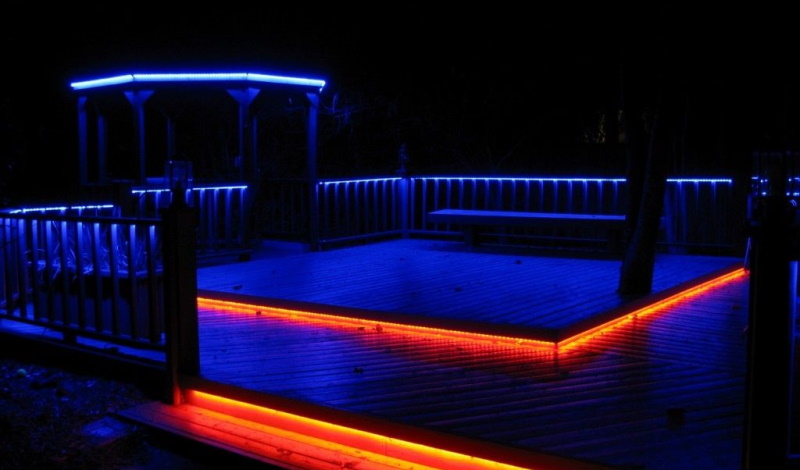
Long Length outdoor project
Digital RGBW LED strip (5v sk6812)
A competing LED chip called the sk6812 is available in RGBW variants, if your library or software is compatible with this (WLED is for instance) it can provide very beautiful colors and effects. It’s a very good chip and has worked well for me with various software such as WLED!
![]() 5m, 30LEDs/m, 5v, sk6812, RGBW (Only on Aliexpress)
5m, 30LEDs/m, 5v, sk6812, RGBW (Only on Aliexpress)
![]() 1m, 144 LEDs/m, 5v, sk6812, RGBW
1m, 144 LEDs/m, 5v, sk6812, RGBW
![]()
5m, 60LEDs/m, 12v, sk6812, RGBW !Special, 12v sk6812 RGBW (per 3 addressable)!
2023 — update
24v sk6812 isn’t always available. A new variants from ws called ws2814 is now also available. It uses an external chip instead of an internal but one other then that basically provides the same specifications as sk6812 RGBW and works well! They are also already included in the real-world power sheet! You need WLED v0.14 or newer to run them properly.
![]() 5m, 60LEDs/m, 12v / 24v, ws2814, RGBW
5m, 60LEDs/m, 12v / 24v, ws2814, RGBW
A SK6812 RGBW strip with warm white
Digitally Addressable White LEDs
All color LEDs (addressable or not) make horrible white by combining colors. You can use RGBW strip like the SK6812 variant mentioned above but if you need more light or more colors white LED there are more options available. These are still not considered great for usable for general purpose lighting however, their the CRI value is unknown (unstated) and in testing they look decent but still not CRI90 which I consider the minimum for primary lighting tasks. The only CRI90 option I know of that comes close to consider for this purpose is the new 768LEDs/m COB RGBW variant listed here. If you however have a project that requires 3 colors of white light, these WWA stip can be great to use!
![]() 5m 60LEDs/m or 96LEDs/m, 5v, sk6812, WWA (Warm White + Cool White + Amber Color) (Aliexpress only)
5m 60LEDs/m or 96LEDs/m, 5v, sk6812, WWA (Warm White + Cool White + Amber Color) (Aliexpress only)
High persistence of vision/Best color
If you need a very high PWM frequency for persistence of vision or need the best color mixing abilities available or need to feed the LED strip at maximum FPS values thinkable it used to be a chip called “APA102” but in more recent years the “HD107s” chip has shown some nice improvements over it while using the same protocol. These are both dual wire LED strips which means they need a “data” wire and a “clock” wire. A single set of these can be run on the Dig-Uno/Quad or Dig-Octa system with WLED v0.14.
Ending remarks
After reading this and you might be looking for a different form of LEDs like COB strip of bullet pixels, take a look at my other articles here.
As you can see there is a whole lot of different addressable LED strip available, each with their own advantages and disadvantages. The generic 5v ws2812b LED strips are certainly still the cheapest and most used, but if you are going to use anything but the 30LEDs/m variant you really need to think about either adding a lot of power wires or using the newer 12v ws2815 LED strip which can make cabling much easier especially in smaller (up to 10m) setups!
If your controller supports higher voltages such as 12v and 24v (which the Dig-Uno/Quad or Dig-Octa system do) a lot of things become easier in regards to power wiring, voltage drop, etc.. the downside is generally per 3 addressable or more with higher voltages. My guide on power injections (and total power calculations, injection calculations, etc. etc.) is highly recommended to follow taking the guess work out of your install and giving you clear instructions on what to arrange!
After getting your LED strips, also make sure to get a power supply, and maybe some wires and other tools you might need.

